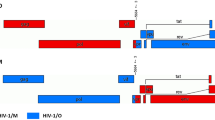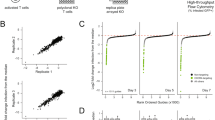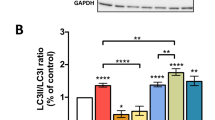Abstract
In the mouse, replication of human immunodeficiency virus type 1 (HIV) is blocked at the levels of entry, transcription and assembly. For the latter effect, the amounts of unspliced viral genomic RNA could have an important function. Indeed, in murine cells, HIV transcripts are spliced excessively, a process that is not inhibited by the murine splicing inhibitor p32 (mp32). In marked contrast, its human counterpart, hp32, not only blocks this splicing but promotes the accumulation of viral genomic transcripts and structural proteins, resulting in the assembly and release of infectious virions. A single substitution in hp32 of Gly 35 to Asp 35, which is found in mp32, abrogates this activity. Thus, hp32 overcomes an important post-transcriptional block to HIV replication in murine cells.
This is a preview of subscription content, access via your institution
Access options
Subscribe to this journal
Receive 12 print issues and online access
$259.00 per year
only $21.58 per issue
Buy this article
- Purchase on SpringerLink
- Instant access to full article PDF
Prices may be subject to local taxes which are calculated during checkout






Similar content being viewed by others
References
Lewis, A.D. & Johnson, P.R. Developing animal models for AIDS research — progress and problems. Trends Biotechnol. 13, 142–150 (1995).
Maddon, P.J. et al. The T4 gene encodes the AIDS virus receptor and is expressed in the immune system and the brain. Cell 47, 333–348 (1986).
Lores, P. et al. Expression of human CD4 in transgenic mice does not confer sensitivity to human immunodeficiency virus infection. AIDS Res. Hum. Retroviruses 8, 2063–2071 (1992).
Berger, E.A., Murphy, P.M. & Farber, J.M. Chemokine receptors as HIV-1 coreceptors: roles in viral entry, tropism, and disease. Annu. Rev. Immunol. 17, 657–700 (1999).
Sawada, S. et al. Disturbed CD4+ T cell homeostasis and in vitro HIV-1 susceptibility in transgenic mice expressing T cell line-tropic HIV-1 receptors. J. Exp. Med. 187, 1439–1449 (1998).
Browning, J. et al. Mice transgenic for human CD4 and CCR5 are susceptible to HIV infection. Proc. Natl Acad. Sci. USA 94, 14637–14641 (1997).
Garber, M.E. & Jones, K.A. HIV-1 Tat: coping with negative elongation factors. Curr. Opin. Immunol. 11, 460–465 (1999).
Taube, R., Fujinaga, K., Wimmer, J., Barboric, M. & Peterlin, B.M. Tat transactivation: a model for the regulation of eukaryotic transcriptional elongation. Virology 264, 245–253 (1999).
Garber, M.E. et al. The interaction between HIV-1 Tat and human cyclin T1 requires zinc and a critical cysteine residue that is not conserved in the murine CycT1 protein. Genes Dev. 12, 3512–3527 (1998).
Trono, D. & Baltimore, D. A human cell factor is essential for HIV-1 Rev action. EMBO J. 9, 4155–4160 (1990).
Shukla, R.R., Marques, S.M., Kimmel, P.L. & Kumar, A. Human chromosome 6- and 11-encoded factors support human immunodeficiency virus type 1 Rev function in A9 cells. J. Virol. 70, 9064–9068 (1996).
Malim, M.H., McCarn, D.F., Tiley, L.S. & Cullen, B.R. Mutational definition of the human immunodeficiency virus type 1 Rev activation domain. J. Virol. 65, 4248–4254 (1991).
Bieniasz, P.D. & Cullen, B.R. Multiple blocks to human immunodeficiency virus type 1 replication in rodent cells. J. Virol. 74, 9868–9877 (2000).
Reed, M. et al. Chimeric human immunodeficiency virus type 1 containing murine leukemia virus matrix assembles in murine cells. J. Virol. 76, 436–443 (2002).
Mariani, R. et al. A block to human immunodeficiency virus type 1 assembly in murine cells. J. Virol. 74, 3859–3870 (2000).
Mariani, R. et al. Mouse–human heterokaryons support efficient human immunodeficiency virus type 1 assembly. J. Virol. 75, 3141–3151 (2001).
Chen, B.K., Rousso, I., Shim, S. & Kim, P.S. Efficient assembly of an HIV-1/MLV Gag-chimeric virus in murine cells. Proc. Natl Acad. Sci. USA 98, 15239–15244 (2001).
Purcell, D.F. & Martin, M.A. Alternative splicing of human immunodeficiency virus type 1 mRNA modulates viral protein expression, replication and infectivity. J. Virol. 67, 6365–6378 (1993).
Peterlin, B.M. & Trono, D. Hide, shield and strike back: how HIV-infected cells avoid immune eradication. Nature Rev. Immunol. 3, 97–107 (2003).
Pollard, V.W. & Malim, M.H. The HIV-1 Rev protein. Annu. Rev. Microbiol. 52, 491–532 (1998).
Chang, D.D. & Sharp, P.A. Regulation by HIV Rev depends upon recognition of splice sites. Cell 59, 789–795 (1989).
Wang, S.W. & Aldovini, A. RNA incorporation is critical for retroviral particle integrity after cell membrane assembly of Gag complexes. J. Virol. 76, 11853–11865 (2002).
Tokunaga, K. et al. Enhancement of human immunodeficiency virus type 1 infectivity by Nef is producer cell-dependent. J. Gen. Virol. 79, 2447–2453 (1998).
He, J. et al. Human immunodeficiency virus type 1 viral protein R (Vpr) arrests cells in the G2 phase of the cell cycle by inhibiting p34cdc2 activity. J. Virol. 69, 6705–6711 (1995).
Hope, T.J., Huang, X.J., McDonald, D. & Parslow, T.G. Steroid–receptor fusion of the human immunodeficiency virus type 1 Rev transactivator: mapping cryptic functions of the arginine-rich motif. Proc. Natl Acad. Sci. USA 87, 7787–7791 (1990).
Luo, Y., Yu, H. & Peterlin, B.M. Cellular protein modulates effects of human immunodeficiency virus type 1 Rev. J. Virol. 68, 3850–3856 (1994).
Smith, C.W. & Valcarcel, J. Alternative pre-mRNA splicing: the logic of combinatorial control. Trends Biochem. Sci. 25, 381–388 (2000).
Hastings, M.L. & Krainer, A.R. Pre-mRNA splicing in the new millennium. Curr. Opin. Cell Biol. 13, 302–309 (2001).
Tange, T.O. & Kjems, J. SF2/ASF binds to a splicing enhancer in the third HIV-1 tat exon and stimulates U2AF binding independently of the RS domain. J. Mol. Biol. 312, 649–662 (2001).
Powell, D.M., Amaral, M.C., Wu, J.Y., Maniatis, T. & Greene, W.C. HIV Rev-dependent binding of SF2/ASF to the Rev response element: possible role in Rev-mediated inhibition of HIV RNA splicing. Proc. Natl Acad. Sci. USA 94, 973–978 (1997).
Pongoski, J., Asai, K. & Cochrane, A. Positive and negative modulation of human immunodeficiency virus type 1 Rev function by cis and trans regulators of viral RNA splicing. J. Virol. 76, 5108–5120 (2002).
Krainer, A.R., Mayeda, A., Kozak, D. & Binns, G. Functional expression of cloned human splicing factor SF2: homology to RNA-binding proteins, U1 70K, and Drosophila splicing regulators. Cell 66, 383–394 (1991).
Petersen-Mahrt, S.K. et al. The splicing factor-associated protein, p32, regulates RNA splicing by inhibiting ASF/SF2 RNA binding and phosphorylation. EMBO J. 18, 1014–1024 (1999).
Tange, T.O., Jensen, T.H. & Kjems, J. In vitro interaction between human immunodeficiency virus type 1 Rev protein and splicing factor ASF/SF2-associated protein, p32. J. Biol. Chem. 271, 10066–10072 (1996).
Jiang, J., Zhang, Y., Krainer, A.R. & Xu, R.M. Crystal structure of human p32, a doughnut-shaped acidic mitochondrial matrix protein. Proc. Natl Acad. Sci. USA 96, 3572–3577 (1999).
Amendt, B.A., Hesslein, D., Chang, L.J. & Stoltzfus, C.M. Presence of negative and positive cis-acting RNA splicing elements within and flanking the first tat coding exon of human immunodeficiency virus type 1. Mol. Cell Biol. 14, 3960–3970 (1994).
Staffa, A. & Cochrane, A. Identification of positive and negative splicing regulatory elements within the terminal tat-rev exon of human immunodeficiency virus type 1. Mol. Cell. Biol. 15, 4597–4605 (1995).
Wentz, M.P., Moore, B.E., Cloyd, M.W., Berget, S.M. & Donehower, L.A. A naturally arising mutation of a potential silencer of exon splicing in human immunodeficiency virus type 1 induces dominant aberrant splicing and arrests virus production. J. Virol. 71, 8542–8551 (1997).
Caputi, M. & Zahler, A.M. SR proteins and hnRNP H regulate the splicing of the HIV-1 tev-specific exon 6D. EMBO J. 21, 845–855 (2002).
Cullen, B.R. Nuclear RNA export pathways. Mol. Cell. Biol. 20, 4181–4187 (2000).
Li, J., Liu, Y., Park, I.W. & He, J.J. Expression of exogenous Sam68, the 68-kilodalton SRC-associated protein in mitosis, is able to alleviate impaired Rev function in astrocytes. J. Virol. 76, 4526–4535 (2002).
Reddy, T.R. et al. Inhibition of HIV replication by dominant negative mutants of Sam68, a functional homolog of HIV-1 Rev. Nature Med. 5, 635–642 (1999).
Horton, R.M., Cai, Z.L., Ho, S.N. & Pease, L.R. Gene splicing by overlap extension: tailor-made genes using the polymerase chain reaction. Biotechniques 8, 528–535 (1990).
Neumann, J.R., Morency, C.A. & Russian, K.O. A novel rapid assay for chloramphenicol acetyl transferase gene expression. Biotechniques 5, 444–447 (1987).
Acknowledgements
We thank D. Irwin for excellent technical assistance. We thank A. Adachi and K. Tokunaga for pNL-CAT (pNLenCAT) proviral clone, N. Landau for pNL-Luc (pNL-luc-E−R−) proviral clone and MGT5 cell line, A. Krainer for p32 and ASF/SF2 cDNAs, P. Bieniasz for pBS/HIV(78-340), and the National Institutes of Health (NIH) AIDS Research and Reference Reagent Program for various reagents. This work was supported by Research Grants from the NIH (B.M.P.), California University-wide AIDS Research Program (B.M.P., Y.-H.Z.) and a training grant from the NIH (Y.-H.Z.).
Author information
Authors and Affiliations
Corresponding author
Ethics declarations
Competing interests
The authors declare no competing financial interests.
Rights and permissions
About this article
Cite this article
Zheng, YH., Yu, HF. & Peterlin, B. Human p32 protein relieves a post-transcriptional block to HIV replication in murine cells. Nat Cell Biol 5, 611–618 (2003). https://doi.org/10.1038/ncb1000
Received:
Accepted:
Published:
Issue date:
DOI: https://doi.org/10.1038/ncb1000
This article is cited by
-
Association of the host genetic factors, hypercholesterolemia and diabetes with mild influenza in an Iranian population
Virology Journal (2021)
-
Human gene encoding hyaluronan binding protein 1 (HABP1/p32/gC1qR): involvement in signaling cascade
The Nucleus (2017)
-
Rev and Rex proteins of human complex retroviruses function with the MMTV Rem-responsive element
Retrovirology (2009)
-
Synergistic effect of human CycT1 and CRM1 on HIV-1 propagation in rat T cells and macrophages
Retrovirology (2009)
-
Inhibition of HIV-1 gene expression by Ciclopirox and Deferiprone, drugs that prevent hypusination of eukaryotic initiation factor 5A
Retrovirology (2009)



